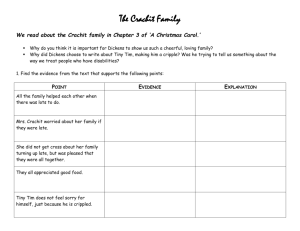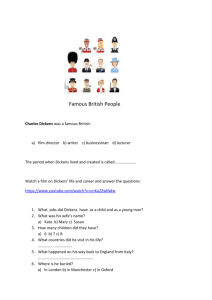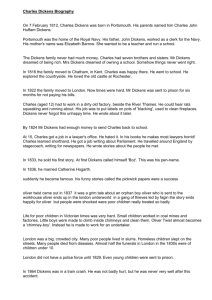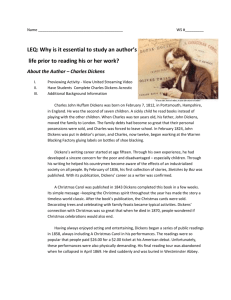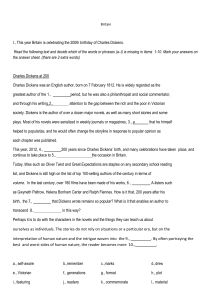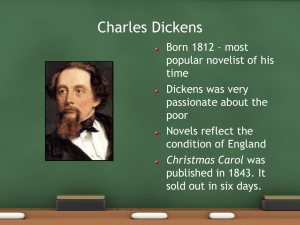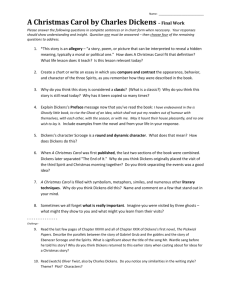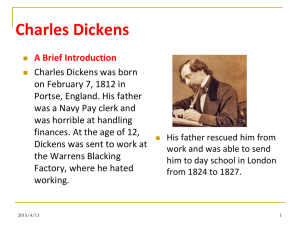Paper-Saving Version - Unitarian Universalist Association
advertisement
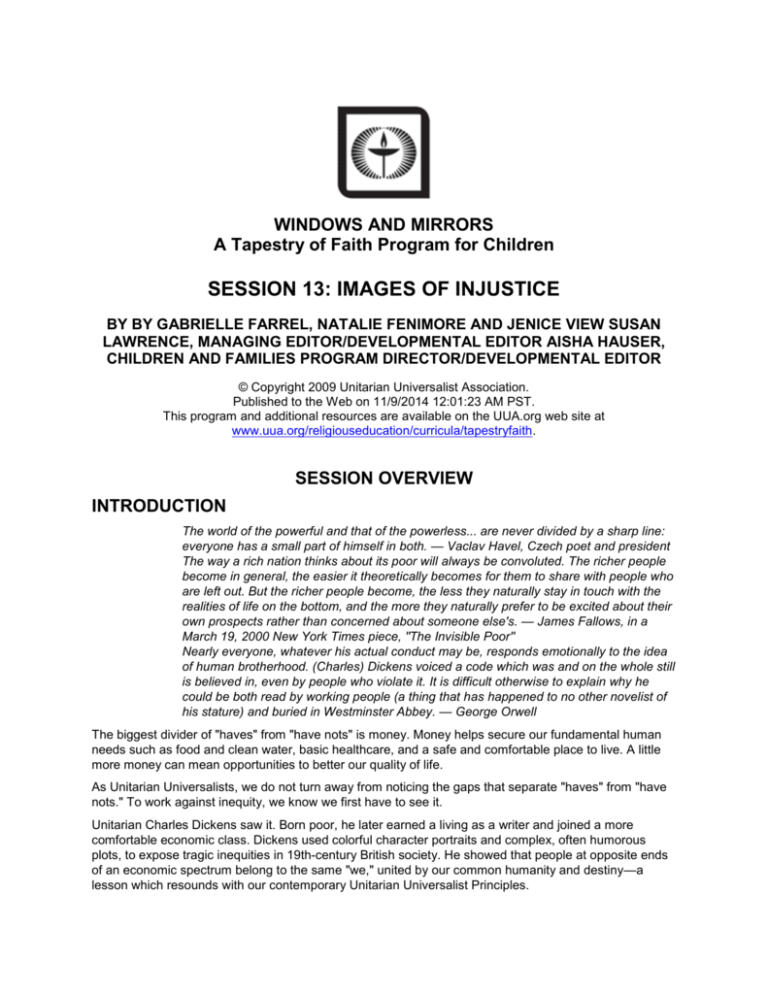
WINDOWS AND MIRRORS A Tapestry of Faith Program for Children SESSION 13: IMAGES OF INJUSTICE BY BY GABRIELLE FARREL, NATALIE FENIMORE AND JENICE VIEW SUSAN LAWRENCE, MANAGING EDITOR/DEVELOPMENTAL EDITOR AISHA HAUSER, CHILDREN AND FAMILIES PROGRAM DIRECTOR/DEVELOPMENTAL EDITOR © Copyright 2009 Unitarian Universalist Association. Published to the Web on 11/9/2014 12:01:23 AM PST. This program and additional resources are available on the UUA.org web site at www.uua.org/religiouseducation/curricula/tapestryfaith. SESSION OVERVIEW INTRODUCTION The world of the powerful and that of the powerless... are never divided by a sharp line: everyone has a small part of himself in both. — Vaclav Havel, Czech poet and president The way a rich nation thinks about its poor will always be convoluted. The richer people become in general, the easier it theoretically becomes for them to share with people who are left out. But the richer people become, the less they naturally stay in touch with the realities of life on the bottom, and the more they naturally prefer to be excited about their own prospects rather than concerned about someone else's. — James Fallows, in a March 19, 2000 New York Times piece, "The Invisible Poor" Nearly everyone, whatever his actual conduct may be, responds emotionally to the idea of human brotherhood. (Charles) Dickens voiced a code which was and on the whole still is believed in, even by people who violate it. It is difficult otherwise to explain why he could be both read by working people (a thing that has happened to no other novelist of his stature) and buried in Westminster Abbey. — George Orwell The biggest divider of "haves" from "have nots" is money. Money helps secure our fundamental human needs such as food and clean water, basic healthcare, and a safe and comfortable place to live. A little more money can mean opportunities to better our quality of life. As Unitarian Universalists, we do not turn away from noticing the gaps that separate "haves" from "have nots." To work against inequity, we know we first have to see it. Unitarian Charles Dickens saw it. Born poor, he later earned a living as a writer and joined a more comfortable economic class. Dickens used colorful character portraits and complex, often humorous plots, to expose tragic inequities in 19th-century British society. He showed that people at opposite ends of an economic spectrum belong to the same "we," united by our common humanity and destiny—a lesson which resounds with our contemporary Unitarian Universalist Principles. This session challenges participants: How can we look at our world as Dickens looked at his, take compassionate note of poverty, and see where humanity is needed? Note: The first activity asks you to introduce the group to Dickens' portrayal of "have-not" children and their lives. While it may be best to prepare to describe and summarize Oliver Twist, A Christmas Carol and perhaps others, we suggest a number of book and video resources in Activity 1 and in the Find Out More section. GOALS This session will: Demonstrate the value of observing and documenting inequities as a step toward promoting economic justice Guide children to observe a society in terms of its "haves" and "have-nots" Introduce author Charles Dickens as a prophetic voice from our Unitarian Universalist heritage whose tales presaged the first and seventh Principles we affirm and promote today. LEARNING OBJECTIVES Participants will: Learn about 19th-century Unitarian writer Charles Dickens Learn the terms "haves" and "have-nots" and apply them to Dickens' society and our own Explore how contemporary media portray extreme poverty and extreme wealth Identify specific ways for awareness of inequities to guide our faithful actions Reflect on their own lives, in terms of "abundance" or "scarcity," and express this reflection on their individual Window/Mirror Panels. SESSION-AT-A-GLANCE Activity Minutes Opening 5 Activity 1: Meet Oliver Twist 10 Activity 2: Story — Charles Dickens 5 Activity 3: Victorian Parlor Games 10 Activity 4: Finding the Poor 15 Activity 5: Window/Mirror Panel — Reflection on Abundance and Scarcity 10 Faith in Action: Changing, Like Scrooge Closing 5 Alternate Activity 1: A Dickensian Drama 15 Alternate Activity 2: Dickens, the Movie SPIRITUAL PREPARATION Find a place where you can be quiet with your thoughts. Make yourself comfortable; light a candle to mark the time as different from your other activities. Close your eyes and breathe deeply and perhaps repeat a word or phrase to separate you from the activities of the day. Allow images of extreme economic poverty to pass through your mind. What do you see? Are these scenes you have witnessed, lived, read about or seen depicted in a movie or on television? How do these images make you feel? In what ways do they make you uncomfortable? In what ways do they make you feel inspired or called to make a difference? Charles Dickens' close, loving observation and warm humor made extreme poverty less painful to recognize and more compelling to fight against. In today's session, how can you help children welcome and respond faithfully to information about the lives of people who are our society's have-nots? SESSION PLAN OPENING (5 MINUTES) Materials for Activity Chalice or LED/battery-operated candle Large, round mirror to hold the chalice Reflective materials, such as beads or pieces of stained glass Newsprint, markers and tape Opening Words Basket and opening words (see Session 1, Leader Resource 1 (at www.uua.org/re/tapestry/children/windows/session1/sessionplan/leaderresources/143368.shtml)) Optional: A copy of the Unitarian Universalist hymnbook, Singing the Living Tradition Optional: Bell , chime or other sound instrument Preparation for Activity Set up the chalice on the mirror to enhance its reflection. The chalice may be filled with reflective materials, such as beads or pieces of stained glass, to represent the idea of light, reflection and mirrors. Write the words to "Spirit of Life," Hymn 123 in Singing the Living Tradition, or another hymn you prefer, on newsprint, and post somewhere everyone can see it. Obtain a basket to hold numerous slips of paper with opening words. Print Session 1, Leader Resource 1, Opening Words for Basket; cut out the short readings and place them in the basket. Of course, feel free to add your own. Prepare to lead the group in singing "Spirit of Life," or another song commonly sung in your congregation. Optional: Arrange to have someone else who is musical lead the singing, perhaps with instrumental accompaniment. Description of Activity This ritual welcoming reminds participants of the relational nature of the group experience. Gather the children in a circle around the chalice. Invite them to take a deep breath and release it, and create a deep silence for a moment. Ask a volunteer to take a reading from the Opening Words Basket and read it aloud. Invite another volunteer to light the chalice. Then, lead a greeting: Now we will take a moment to greet the people next to us. If you are next to someone who is new to our group, offer a welcome, tell them your first and last name, and learn their name. Lead the group in singing the hymn you have chosen. Singing a congregational favorite helps children grow in their sense of belonging in congregational life. If you choose not to sing, use a bell to signal the group to still themselves for another moment of silence. Ask the child who lit the chalice to extinguish it. Ask the child who read the opening words to return the reading to the Opening Words Basket. Including All Participants If you have a non-sighted participant who reads braille, obtain the braille version of Singing the Living Tradition from UUA Bookstore. The bookstore orders from an outside publisher, so order several weeks ahead. ACTIVITY 1: MEET OLIVER TWIST (10 MINUTES) Materials for Activity A copy, preferably illustrated, of Oliver Twist (included in this document) by Charles Dickens Optional: Additional books by Charles Dickens, such as A Christmas Carol Optional: A DVD or videotape of the musical, Oliver! or another film based on a story by Charles Dickens, and appropriate equipment Preparation for Activity Familiarize yourself with the plot (at www.novelguide.com/olivertwist/novelsummary.html) and themes (at www.novelguide.com/olivertwist/themeanalysis.html) of Oliver Twist. You may decide to read aloud a brief excerpt to the group; however, it is recommended that you convey the flavor and topics of his writing by description instead. Dickens' language and subtle irony may be difficult for children this age to apprehend, especially out of the context of the entire story. You may like to present Dickens's voice by reading aloud his tale, A Christmas Carol. Find a version in your local library. Optional: If you have the time and the appropriate equipment, show the group a short excerpt from one of the many films based on Oliver Twist or A Christmas Carol. The song, "Food, Glorious Food!" from Oliver! or a clip from the Walt Disney story of Scrooge McDuck may work. View the film in advance to choose one or two short clips that demonstrate Dickens's focus on the gap between "haves" and "have nots," and his awareness of the humanity that all people share. See film suggestions in Resources, Find Out More. Description of Activity Share one or more of Dickens' stories about children who were "have-nots" in 19th-century Britain by describing the story, reading an excerpt aloud, showing a video clip or any combination. Introduce the phrase "haves and have-nots," which dates from Dickens' time. "Have-nots" are individuals who lack money, wealth and other material resources—as contrasted with "haves." Process the scenes or stories, using these questions: How does Charles Dickens portray the lives of people who are disadvantaged? Does it seem he might have lived in these conditions, himself? How else would he know so much about being poor? What are some details that show some people have more money than others? How does Charles Dickens show who are "haves" and who are "have-nots?" Where do we see inequities like these in our society? If Dickens were writing a story about today, what do you think he would write about? Point out that Dickens' time and place was noted for its extremes of wealth and poverty. The people we think of as middle class, somewhere between haves and have-nots, were a much smaller part of 19th- century British society, quite different from the way middle class people—the have-somes?—are the majority in the U.S. today. ACTIVITY 2: STORY — CHARLES DICKENS (5 MINUTES) Materials for Activity A copy of the story "Charles Dickens (included in this document) " A bell, chime, rain stick or other musical noisemaker Preparation for Activity Read the story a few times. Consider telling it dramatically, rather than reading it from the page. Practice telling it. The stories here are written for a Story for All Ages moment—part performance, part ministry. For storytelling, be ritualistic. Create a mood and a time that is different from other moments in the session. For example, turn overhead lights off and use lamps. Position yourself where all can see and hear you. You may wish to wear a storytelling shawl. Review the discussion questions. Choose some you think might resonate with the group and help these particular children interpret the story and relate it to their own lives. Description of Activity Tell the group you will tell them a bit more about Charles Dickens. Ring the chime (or other noisemaker), make eye contact with each participant and read or tell the story. Sound the chime (or other noisemaker) again at the end. Use these questions to facilitate discussion. Make sure everyone who wants to speak has a chance. What do you think made Charles Dickens want to write about people who were extremely poor, after he was no longer poor himself? If you lived at the time of Dickens, and you could read and had time for it, what would you think of his stories? Would you want to read them or not? Conclude by affirming: Charles Dickens was a good observer, a creative writer and someone who did not believe poverty should be hidden. He used his talent for writing stories to help everyone see things that were not equal and not fair in his world. ACTIVITY 3: VICTORIAN PARLOR GAMES (10 MINUTES) Materials for Activity For Lookabout: A small object For Charades: Scrap paper and pencils for all participants, two baskets or bowls, a timepiece with a second hand Preparation for Activity Arrange chairs or identify a carpeted area for children to sit in a circle. Optional: For Charades, you may wish to prepare a list of Charles Dickens book and story titles, a list of phrases from the Unitarian Universalist Principles or a list of names of congregational members and staff for children to act out. If you prepare the phrases, you need not form teams; instead, invite one volunteer at a time to mime for the group. Description of Activity Gather in a seated circle. Tell the children: In Charles Dickens's day, in England , indoor games were popular with all ages. There wasn't much equipment needed so the very wealthy or the very poor might have played the same games. Let's play a few now to experience how Charles Dickens and his family might have spent a Sunday afternoon. Lead as many games as time allows. Lookabout Ask a volunteer to be the hider and give them a small object. The hider shows it to the others, who then leave the room. Ask the hider to hide it someplace the lookers can see it without having to move anything out of the way. Bring others back and invite everyone to look for the item in silence. When they spot the item, they should sit down. The last one looking becomes the next hider. Forfeits One person volunteers to be the auctioneer, and leaves the room. Each of the others "forfeits" a special item that belongs to them and sets it in the center of the circle. Then, the auctioneer returns and chooses an item to "sell." In order not to forfeit their item, the owner must claim it and do something the auctioneer or the group requests. Owners may choose to forfeit an item instead of complying with a request; auctioneers might say "Going once, going twice, not sold!" and move on to another item. To give multiple participants a chance to be the auctioneer, invite each child who reclaims an item to auction off the next item. However, allow the original auctioneer to continue choosing the items for "sale," as they are the only child who will not know who forfeited which item. Set parameters for requests ahead of time; participants might be asked to sing, dance, balance a book on their head, tell a riddle or a "knock-knock" joke, etc. Make sure items are returned to their owners after the game. The Minister's Cat Choose a participant to go first. Move clockwise around the circle to continue. The first player describes the minister's cat with an adjective beginning with an "a;" for example, "The minister's cat is an awkward cat." The second player describes the minister's cat with an adjective beginning with a "b," the third uses an adjective beginning with a "c," and so on. When the alphabet is done, start again with "a." A player is "out" when they cannot think of an adjective or they say one already used. You can set a pace and time limits by having the group clap on their thighs throughout the game; players who miss their rhythm cue are "out." Charades Charades is the quintessential parlor game. Form two teams and ask each to gather on opposite sides of the room. Distribute paper and pencils to all participants and give each team a basket. Instruct each person to write down a common phrase, famous person's name, book title or movie title on paper, fold the paper, and place it in the basket. Teams alternate turns. For each turn, one team member chooses a paper from the basket and acts out what's on it so their teammates can guess the phrase, person, book title or movie title. Common charades gestures are: Miming opening a book or cranking an old-fashioned movie camera Fingers held up to indicate the number of words in a phrase Fingers placed on forearm to indicate the number of syllables in a word. Fingers held up to indicate which word or which syllable will be mimed Miming stretching a string to indicate a longer version of a word that has been guessed. Including All Participants If the group includes children with vision impairment, do not play Lookabout or Charades. ACTIVITY 4: FINDING THE POOR (15 MINUTES) Materials for Activity A variety of current newspapers, news magazines and lifestyle magazines Pads of sticky notes, one for each small group Optional: Audio/visual media and appropriate equipment Newsprint, markers and tape Preparation for Activity Collect newspapers and magazines for participants to explore. You may wish to identify with sticky notes the publications participants may cut up for a collage in Activity 5, Window/Mirror Panel. If you plan to include audio/visual media, obtain and text needed equipment. Description of Activity Form groups of three to five children at work tables. Assign each adult facilitator several groups to assist. Give each group a pad of sticky notes and an assortment of newspapers and magazines. Say: Today, we can get more information about the world than anyone in Charles Dickens's time could. And our world certainly has extreme poverty. But do we get information about the people living in poverty? Maybe we need another Charles Dickens today. In your groups, look in the newspapers and magazines (and/or, listen to television, radio, and/or Internet news). Mark with sticky notes (or write notes about) the information you find about people who do not have enough money to live safe and healthy lives. Observe the details you read, see or hear about people's lives in extreme poverty. Give groups five minutes. Then re-gather and let each group present one or two of their findings and/or respond to these questions: Was it easy or difficult to find images/stories of very poor people? What details told you when you found something about people in poverty? How true do you think the images/stories are? Why? You may like to post blank newsprint and use it to record the details they mention on newsprint. When all the small groups have presented, lead a discussion with the whole group: How do you feel when you take time to examine fully these pictures of economic want? What do you feel you could do? What do you feel you ought to do? What do you feel resistant to? What do you NOT want to do? Affirm all responses. One goal is to help participants articulate the discomfort that can result from seeing others in real distress. Use the discomfort that emerges to help children understand we are all connected to all human experience. Conclude by saying something like: When you have an opportunity to be of service or to share what you have, remember that there is real human need and you can make a difference. Including All Participants Include non-sighted participants by adding audio/visual media. Obtain the equipment to provide news programming from television, radio or streaming internet for this activity. Assign a mixed group of sighted and non-sighted participants to monitor audio/visual news for reports of extreme poverty. ACTIVITY 5: WINDOW/MIRROR PANEL — REFLECTION ON ABUNDANCE AND SCARCITY (10 MINUTES) Preparation for Activity Collect illustrated magazines for participants to cut up. If needed, purchase stickers with images children may want to use in this activity. Have materials easily accessible. Description of Activity Invite the children to bring their Window/Mirror Panels to work tables. Distribute Window/Mirror Panel basket(s) and pre-cut paper if you have prepared some. Say: Let's imagine Charles Dickens is coming to take a look at our Window/Mirror Panels. Remember, he was a very observant person. Would he find us to be a community of abundance or scarcity? Would he see extreme wealth, extreme need, something in between or a mixture? Decorate a piece for your panel that expresses who you are in terms of abundance (having more than you need) or scarcity (not having enough). For your illustration or collage, you can include pictures of real things, drawings (either abstract or representational), words or any combination. Feel free to be comical and exaggerate your wealth or your poverty, as Dickens often did. Walk around and assist. Some participants may need to engage verbally before they find their direction in this relatively unstructured assignment. You may want to offer that the shiny materials in the Window/Mirror Panel baskets might be one way to convey "wealth." Give the group a two-minute warning so they have time to complete their projects, affix them to their Window/Mirror panels, clean up and store their panels. CLOSING Materials for Activity Newsprint, markers and tape Taking It Home handout Optional: A copy of Session 1, Leader Resource 2, Namaste Preparation for Activity Identify a place for participants to store their Window/Mirror Panels between sessions. Keep in mind, there may be times the panels are not entirely dry when the session ends. Write the closing words on newsprint and post. Download and adapt the Taking It Home section and copy as a handout for all participants (or, email to parents). Optional: Review the leader resource so you can briefly explain the origin and meaning of “namaste” and demonstrate the accompanying gesture. Description of Activity Explain that the session is almost over and we now have to work together as community to clean the meeting space. First, everyone should clean up their own personal area, put away materials they were using and store their Window/Mirror Panel. Then they may clean another area or help someone else. No one should sit in the circle until all are done. Then bring the group back to the circle. Ask them to think about what happened today that was good or what they wish had gone better. If you are running short of time you can ask them for a “thumbs up” or “thumbs down” on the session. Invite each participant to say, in a word or sentence, why it is important for them to be a part of this faith community. You may go around the circle for responses; allow individuals to speak or pass. Then ask everyone to hold hands and say together: Keep alert; Stand firm in your faith; Be courageous and strong; Let all that you do be done in love. — 1 Corinthians 16 If this is the first time the group is using “namaste,” briefly explain its origin and meaning. Then, lead the group in the word and bowing gesture. Or, substitute “thank you.” Invite each participant to bow their head to the individuals on either side and then bow to the center of the circle and say “thank you” together. Distribute the Taking It Home handout you have prepared. Thank and dismiss participants. FAITH IN ACTION: CHANGING, LIKE SCROOGE Materials for Activity Optional: A book or film version of A Christmas Carol Newsprint, markers and tape Preparation for Activity Find out about charity projects that will accept new or gently used items donated by children. Possibilities include homeless shelters for families and children, organizations serving children in foster care, international aid organizations and Gulf Coast relief organizations still working to resettle families. If possible, obtain printed information about the project you will ask the group to support. Prepare a note to parents that describes this project and explains when and where children may bring items to donate. In your note, ask for the help you will need to collect, sort and deliver items. Description of Activity Read aloud part of Charles Dickens's A Christmas Carol or show some or all of a film version (see Find Out More). Tell the children: Ebenezer Scrooge saw that his greed and selfishness were directly responsible for the Cratchit family's hunger and poor health. Dickens was NOT saying we cause others' misery when we treat ourselves well. Instead, he was using Scrooge as an extreme example, to teach us something: When we take more than we need, there is likely someone nearby who needs that extra bit, or more. Present the charity project you have selected. Describe the new or gently used books, socks, scarves, toys or other items you would like children to consider donating to a child who may need them more. Explain that children should consult with their parents before giving away any belongings. Including All Participants The group may include children who cannot or do not donate "extra" items. Plan a donation process that does not put any child on the spot. Avoid conveying any judgment about children's contributions. LEADER REFLECTION AND PLANNING Reflect on and discuss with your co-leader(s): How did the timing go today? What might we do to make it work better? What worked well? What didn't? What connections did children make with the activities and/or the central ideas? How could you tell that was occurring? What connections did you make with the children? What connections did the children make with each other? How was this evident? How could a sense of community be improved with this group? Approach your director of religious education for guidance, as needed. TAKING IT HOME The world of the powerful and that of the powerless... are never divided by a sharp line: everyone has a small part of himself in both. — Vaclav Havel, Czech poet and president The way a rich nation thinks about its poor will always be convoluted. The richer people become in general, the easier it theoretically becomes for them to share with people who are left out. But the richer people become, the less they naturally stay in touch with the realities of life on the bottom, and the more they naturally prefer to be excited about their own prospects rather than concerned about someone else's. — James Fallows, in a March 19, 2000 New York Times piece, "The Invisible Poor" Nearly everyone, whatever his actual conduct may be, responds emotionally to the idea of human brotherhood. (Charles) Dickens voiced a code which was and on the whole still is believed in, even by people who violate it. It is difficult otherwise to explain why he could be both read by working people (a thing that has happened to no other novelist of his stature) and buried in Westminster Abbey. — George Orwell IN TODAY'S SESSION... The children became familiar with Charles Dickens, a Unitarian for part of his life. They heard an excerpt from his novel, Oliver Twist, and explored his technique of painting detailed, sometimes comical portraits of the extremely wealthy and the extremely poor in order to illustrate our common humanity. We investigated current newspapers and magazines for representations of people's lives in extreme poverty today. Children worked on their Window/Mirror Panels. We encouraged them to use comical exaggeration, as Dickens did, to represent themselves as a "have," a "have not" or someone who is a bit of both. EXPLORE THE TOPIC TOGETHER. Talk about... Charles Dickens's portrayals of the very rich and the very poor. Imagine that Dickens could observe your community. Would he find extremes of wealth and poverty? Are there people who lack basic necessities, such as food, clothing, shelter, and health care? Talk frankly about how you as a family perceive yourselves on a continuum of extreme wealth to extreme lack. EXTEND THE TOPIC TOGETHER. Try... A FAMILY DISCOVERY If any family members are unfamiliar with him, introduce them to Charles Dickens's character, Ebenezer Scrooge. Read A Christmas Carol together or view a film version. Aver that Scrooge is comical rather than frightening for two reasons: One, because most people can recognize themselves in him; and two, because in the end, he changes, practically exploding with love, compassion and charity. Talk about times when you have been greedy, and how you might have shared what you had with someone who needed it more. Invite your child and other family members to share their stories. Allow that to be greedy sometimes is human. Try to create an environment in which everyone feels safe talking honestly about times they were not their best selves. Everyone deserves to explore their own actions without risking others' judgment. A FAMILY GAME Teach the terms "abundance" and "scarcity" to the entire family. On a family outing, when watching a television program together or on another occasion, take note of the presence of one condition or the other. Share your findings. You may have some interesting conversations, especially if people disagree about definitions of excess and need. ALTERNATE ACTIVITY 1: A DICKENSIAN DRAMA (15 MINUTES) Materials for Activity Paper and pencils for small groups to use Optional: Simple props suggesting Victorian-era wealth or poverty, such as costume jewelry, dress-up garments and accessories, ragged garments, or food items from a play kitchen A bell, chime, rain stick or other musical noisemaker Preparation for Activity Identify an open area for small groups to present improvised skits. Description of Activity Form small groups of three to seven participants. Tell them that each group will create a Dickens-style skit that illustrates extremes of wealth and poverty. Allow that some group members may opt out of performing the skit as long as enough others are willing to perform and each non-performing child participates meaningfully (as a planner/writer, props person, director, etc.). Invite groups to choose a situation and setting where the very rich and the very poor would naturally encounter one another. You may wish to suggest or assign settings—for example, a playground, a restaurant, a bookstore, a shopping mall, a church or a public park. Give groups five minutes to plan their skits. Sound the chime when time is up, and reconvene the entire group. Invite groups, one at a time, to present their skits. After each skit, guide the entire group to process: What were the poor people like in the skits? What were the rich people like? In what ways were the poor and the rich people alike? What did they have in common? How realistic or exaggerated were your performances? What did it feel like to pretend to be these characters? What can we learn, and how can our faithful actions be guided, by noticing and responding to inequities in our society? Including All Participants Position children with vision or hearing disabilities where they can best experience the movie. ALTERNATE ACTIVITY 2: DICKENS, THE MOVIE Materials for Activity DVD or videotape of a film based on a Charles Dickens story, and appropriate equipment Preparation for Activity Choose a film to show; see Find Out More for an annotated list. Purchase, rent or borrow a DVD or videotape. Preview the film to make sure it is appropriate for the group. If you like, select the excerpt(s) you want to show. Adapt the suggested discussion questions. Make sure to leave time for the group to process their viewing experience immediately after the film. Description of Activity Gather the group. Explain that one reason modern storytellers—movie-makers—like to retell Charles Dickens's stories is that they present a sharp view of economic injustice and at the same time they convey the humanity we all share. If you feel it necessary, offer a context for the story the group will see. Then show the film or excerpt(s). Afterward, invite volunteers to sum up the plot. Pay attention to their version(s) of the story for clues to what most impressed them. Adapt the following questions to lead a discussion. Where do you see extreme poverty in the film? Where do you see excessive wealth? Are the poor always good? Are the rich always bad? What are some human qualities that Dickens seems to admire? o Who in the movie demonstrates those qualities? How? o Which of those qualities are also qualities we value in our Unitarian Universalist faith? How do we show them? If you wanted to tell this story about our current society, who or what might be in your movie? Including All Participants Position children with vision or hearing disabilities where they can best experience the movie. WINDOWS AND MIRRORS: SESSION 13: STORY: CHARLES DICKENS Charles Dickens was born in England in 1812, about 200 years ago. He first earned a living as an assistant in a lawyer's office, then as a newspaper reporter. He was still a young man when he became famous for the funny essays he wrote from his own imagination. At first, no one knew who he was, though, because he used a pseudonym, "Boz." His essays were so popular that Dickens quickly started publishing stories using his own name. Some of them, such as Oliver Twist, Great Expectations and A Christmas Carol, are still told in books and movies today. (Leader: You may wish to pause and invite the group to name Dickens's stories they have read or have seen in a film.) In London , in Dickens's day, many children did not have the chance to go to school. Some lived on the streets and worked or begged for pennies to buy food. Some were so poor they did not have clothes or shoes to wear to school, never mind money for paper, pens, ink or books. Charles Dickens, himself, knew about that sort of poverty. When he was a child, his family was not well off. One time, his father was put in jail because he owed someone money. That year, Charles was 12. He worked at a shoe polish factory instead of going to school. When Charles Dickens was a father with children of his own, some people started a few special schools in London to educate poor children. Dickens gave some of his money to support these Ragged Schools. He used to say the poorest children needed a chance to be clean, too, and the schools should provide warm water for them to wash and take baths. By writing stories and sometimes charging money to tell his stories aloud, Dickens earned plenty of money. He shared his earnings to help provide food, housing, education and hospitals for people who could not afford them. He also believed that people who read his stories might discover more about the needs of others. They might be inspired to help others and work to change society for the better. By 1865, Charles Dickens had written more novels, including David Copperfield, which told some of the story of his own life. Then, Charles Dickens, his friend Ellen Ternan and Ellen's mother were all hurt in a big train accident. He helped some of the passengers escape from the wreckage. He lived only five more years—to the day—after that. Dickens was not the only person of his time who cared about children or the poor. But he played a special role. His popular books influenced politicians, the wealthy and all readers who had the means and the care to help. He helped make the world a better place and his stories still teach us today. WINDOWS AND MIRRORS: SESSION 13: STORY: EXCERPTS FROM OLIVER TWIST The full text of Charles Dickens's 1838 novel, Oliver Twist, can be obtained online at The Literature Network 's website. The novel is copyright-free and in the public domain. Explain that Oliver Twist is a fictional character Charles Dickens created to tell a story. The story begins, just after Oliver is born, with his mother's death in a workhouse for the poor. Oliver's fortunes take him into worlds of economic need that wealthier English people never saw. From Chapter II, "Treats of Oliver Twist's growth, education, and board" The hungry and destitute situation of the infant orphan was duly reported by the workhouse authorities to the parish authorities. The parish authorities inquired with dignity of the workhouse authorities, whether there was no female then domiciled in "the house" who was in a situation to impart to Oliver Twist, the consolation and nourishment of which he stood in need. The workhouse authorities replied with humility, that there was not. Upon this the parish authorities magnanimously and humanely resolved, that Oliver should be "farmed," or, in other words, that he should be dispatched to a branch-workhouse some three miles off, where twenty or thirty other juvenile offenders against the poor-laws, rolled about the floor all day, without the inconvenience of too much food or too much clothing, under the parental superintendence of an elderly female, who received the culprits at and for the consideration of sevenpence-halfpenny per small head per week. Sevenpence-halfpenny's worth per week is a good round diet for a child; a great deal may be got for sevenpence-halfpenny, quite enough to overload its stomach, and make it uncomfortable. The elderly female was a woman of wisdom and experience; she knew what was good for children; and she had a very accurate perception of what was good for herself. So, she appropriated the greater part of the weekly stipend to her own use, and consigned the rising parochial generation to even a shorter allowance than was originally provided for them. Thereby finding in the lowest depth a deeper still; and proving herself a very great experimental philosopher. Everybody knows the story of another experimental philosopher who had a great theory about a horse being able to live without eating, and who demonstrated it so well, that he got his own horse down to a straw a day, and would unquestionably have rendered him a very spirited and rampacious animal on nothing at all, if he had not died, four-and-twenty hours before he was to have had his first comfortable bait of air. Unfortunately for the experimental philosophy of the female to whose protecting care Oliver Twist was delivered over, a similar result usually attended the operation of her system; for at the very moment when a child had contrived to exist upon the smallest possible portion of the weakest possible food, it did perversely happen in eight and a half cases out of ten, either that it sickened from want and cold, or fell into the fire from neglect, or got half-smothered by accident; in any one of which cases, the miserable little being was usually summoned into another world, and there gathered to the fathers it had never known in this. Occasionally, when there was some more than usually interesting inquest upon a parish child who had been overlooked in turning up a bedstead, or inadvertently scalded to death when there happened to be a washing—though the latter accident was very scarce, anything approaching to a washing being of rare occurrence in the farm—the jury would take it into their heads to ask troublesome questions, or the parishioners would rebelliously affix their signatures to a remonstrance. But these impertinences were speedily checked by the evidence of the surgeon, and the testimony of the beadle; the former of whom had always opened the body and found nothing inside (which was very probable indeed), and the latter of whom invariably swore whatever the parish wanted; which was very self-devotional. Besides, the board made periodical pilgrimages to the farm, and always sent the beadle the day before, to say they were going. The children were neat and clean to behold, when they went; and what more would the people have! From Chapter V, "Oliver mingles with new associates. Going to a funeral for the first time, he forms an unfavourable notion of his master's business." Oliver, being left to himself in the undertaker's shop, set the lamp down on a workman's bench, and gazed timidly about him with a feeling of awe and dread, which many people a good deal older than he, will be at no loss to understand. An unfinished coffin on black tressels, which stood in the middle of the shop, looked so gloomy and death-like that a cold tremble came over him, every time his eyes wandered in the direction of the dismal object: from which he almost expected to see some frightful form slowly rear its head, to drive him mad with terror. Against the wall were ranged, in regular array, a long row of elm boards cut into the same shape: looking in the dim light, like high-shouldered ghosts with their hands in their breeches-pockets. Coffin-plates, elm-chips, bright-headed nails, and shreds of black cloth, lay scattered on the floor; and the wall behind the counter was ornamented with a lively representation of two mutes in very stiff neckcloths, on duty at a large private door, with a hearse drawn by four black steeds, approaching in the distance. The shop was close and hot. The atmosphere seemed tainted with the smell of coffins. The recess beneath the counter in which his flock mattress was thrust looked like a grave. ... Nor were these the only dismal feelings which depressed Oliver. He was alone in a strange place; and we all know how chilled and desolate the best of us will sometimes feel in such a situation. The boy had no friends to care for, or to care for him. The regret of no recent separation was fresh in his mind; the absence of no loved and well-remembered face sank heavily into his heart. But his heart was heavy, notwithstanding; and he wished, as he crept into his narrow bed, that that were his coffin, and that he could be lain in a calm and lasting sleep in the church-yard ground, with the tall grass waving gently above his head, and the sound of the old deep bell to soothe him in his sleep. -----------------------------Oliver was awakened in the morning, by a loud kicking at the outside of the shop-door: which before he could huddle on his clothes, was repeated, in an angry and impetuous manner, about twenty-five times. When he began to undo the chain, the legs desisted, and a voice began. "Open the door, will yer?" cried the voice which belonged to the legs which had kicked at the door. "I will, directly, sir," replied Oliver: undoing the chain, and turning the key. "I suppose yer the new boy, ain't yer?" said the voice through the keyhole. "Yes, sir," replied Oliver. "How old are yer?" inquired the voice. "Ten, sir," replied Oliver. "Then I'll whop yer when I get in," said the voice; "you just see if I don't, that's all, my work'us brat!" and having made this obliging promise, the voice began to whistle. Oliver had been too often subjected to the process to which the very expressive monosyllable just recorded bears reference, to entertain the smallest doubt that the owner of the voice, whoever he might be, would redeem his pledge, most honourably. He drew back the bolts with a trembling hand, and opened the door. For a second or two, Oliver glanced up the street, and down the street, and over the way: impressed with the belief that the unknown, who had addressed him through the keyhole, had walked a few paces off, to warm himself; for nobody did he see but a big charity-boy, sitting on a post in front of the house, eating a slice of bread and butter: which he cut into wedges, the size of his mouth, with a clasp knife, and then consumed with great dexterity. "I beg your pardon, sir," said Oliver at length: seeing that no other visitor made his appearance; "did you knock?" "I kicked," replied the charity-boy. "Did you want a coffin, sir?" inquired Oliver, innocently. At this the charity-boy looked monstrous fierce; and said that Oliver would want one before long, if he cut jokes with his superiors in that way. "Yer don't know who I am, I suppose, Work'us?" said the charity-boy, in continuation: descending from the top of the post, meanwhile, with edifying gravity. "No, sir," rejoined Oliver. "I'm Mister Noah Claypole," said the charity-boy, "and you're under me. Take down the shutters, yer idle young ruffian!" With this, Mr. Claypole administered a kick to Oliver, and entered the shop with a dignified air, which did him great credit. It is difficult for a large-headed, small-eyed youth, of lumbering make and heavy countenance, to look dignified under any circumstances; but it is more especially so, when superadded to these personal attractions are a red nose and yellow smalls. Oliver, having taken down the shutters, and broken a pane of glass in his efforts to stagger away beneath the weight of the first one to a small court at the side of the house in which they were kept during the day, was graciously assisted by Noah: who having consoled him with the assurance that "he'd catch it," condescended to help him. Mr. Sowerberry came down soon after. Shortly afterwards, Mrs. Sowerberry appeared. Oliver having "caught it," in fulfillment of Noah's prediction, followed that young gentleman down the stairs to breakfast. "Come near the fire, Noah," said Charlotte . "I saved a nice little bit of bacon for you from master's breakfast. Oliver, shut that door at Mister Noah's back, and take them bits that I've put out on the cover of the bread-pan. There's your tea; take it away to that box, and drink it there, and make haste, for they'll want you to mind the shop. D'ye hear?" "D'ye hear, Work'us?" said Noah Claypole. "Lor, Noah!" said Charlotte , "what a rum creature you are! Why don't you let the boy alone?" "Let him alone!" said Noah. "Why everybody lets him alone enough, for the matter of that. Neither his father nor his mother will ever interfere with him. All his relations let him have his own way pretty well. Eh, Charlotte ? He! he! he!" "Oh, you queer soul!" said Charlotte, bursting into a hearty laugh, in which she was joined by Noah; after which they both looked scornfully at poor Oliver Twist, as he sat shivering on the box in the coldest corner of the room, and ate the stale pieces which had been specially reserved for him. ... They walked on, for some time, through the most crowded and densely inhabited part of the town; and then, striking down a narrow street more dirty and miserable than any they had yet passed through, paused to look for the house which was the object of their search. The houses on either side were high and large, but very old, and tenanted by people of the poorest class: as their neglected appearance would have sufficiently denoted, without the concurrent testimony afforded by the squalid looks of the few men and women who, with folded arms and bodies half doubled, occasionally skulked along. A great many of the tenements had shop-fronts; but these were fast closed, and mouldering away; only the upper rooms being inhabited. Some houses which had become insecure from age and decay, were prevented from falling into the street, by huge beams of wood reared against the walls, and firmly planted in the road; but even these crazy dens seemed to have been selected as the nightly haunts of some houseless wretches, for many of the rough boards which supplied the place of door and window, were wrenched from their positions, to afford an aperture wide enough for the passage of a human body. The kennel was stagnant and filthy. The very rats, which here and there lay putrefying in its rottenness, were hideous with famine. There was neither knocker nor bell-handle at the open door where Oliver and his master stopped; so, groping his way cautiously through the dark passage, and bidding Oliver keep close to him and not be afraid, the undertaker mounted to the top of the first flight of stairs. Stumbling against a door on the landing, he rapped at it with his knuckles. It was opened by a young girl of thirteen or fourteen. The undertaker at once saw enough of what the room contained, to know it was the apartment to which he had been directed. He stepped in; Oliver followed him. There was no fire in the room; but a man was crouching, mechanically, over the empty stove. An old woman, too, had drawn a low stool to the cold hearth, and was sitting beside him. There were some ragged children in another corner; and in a small recess, opposite the door, there lay upon the ground, something covered with an old blanket. Oliver shuddered as he cast his eyes towards the place, and crept involuntarily closer to his master; for though it was covered up, the boy felt that it was a corpse. The man's face was thin and very pale; his hair and beard were grizzly; his eyes were bloodshot. The old woman's face was wrinkled; her two remaining teeth protruded over her under lip; and her eyes were bright and piercing. Oliver was afraid to look at either her or the man. They seemed so like the rats he had seen outside. FIND OUT MORE Charles Dickens A friend and ally of his era's Unitarian thinkers both in England and the U.S. (for example, William Ellery Channing and Ralph Waldo Emerson), Dickens for decades attended a Unitarian church in London . However, he had been raised in the Anglican church and belonged to an Anglican church at the end of his life. Find a detailed biography by Wesley Hromatko (at www25.uua.org/uuhs/duub/articles/charlesdickens.html) on the Dictionary of Unitarian Universalist Biography (at www25.uua.org/uuhs/duub/) website. A 2005 UU World article, "Ebenezer Scrooge ' s Conversion," (at www.uuworld.org/ideas/articles/2273.shtml) by Michael Timko, describes how Charles Dickens's story, A Christmas Carol, exemplified 19th-century Unitarianism. The website Charles Dickens online (at www.dickenslit.com/) has biographical information and many other resources. One source of information for the story "Charles Dickens" was the Hibbert Assembly web site (at www.hibbert-assembly.org.uk/index.html), supported by the Hibbert Trust, founded in 1847 under the will of Unitarian Robert Hibbert. In addition to extensive children's worship and religious education resources to study the life and works of Dickens (at www.hibbert-assembly.org.uk/dickens/index.htm), find resources on other noted Unitarians and spiritual and religious topics. Dickens Literature Resources On David Perdue's Charles Dickens Page (at www.fidnet.com/~dap1955/dickens/carol.html), find a plot summary, copies of the original illustrations and more details from the 1843 publication of A Christmas Carol. The website also provides extensive information and links to other resources for Oliver Twist and many other Dickens works. SparkNote (at www.sparknotes.com/lit/oliver/summary.html)s offers a plot summary for Oliver Twist. Dickens on Film Adaptations of A Christmas Carol available on DVD include the 1970 musical film, Scrooge , (at www.amazon.com/Scrooge-Albert-Finney/dp/B0000AQS5D) starring Albert Finney, and 1951's Scrooge (at www.amazon.co.uk/Scrooge-Alastair-Sim/dp/B00004D0CE), starring Alistair Sim. A 2005 Disney DVD, Classic Cartoon Favorites, vol. 9: Classic Holiday Stories, presents "Mickey's Christmas Carol," in which three Christmas spirits teach Scrooge McDuck to mend his miserly ways. David Lean directed the first film version of Oliver Twist in 1948; Roman Polanski directed another film version (at www.sonypictures.com/homevideo/olivertwist/index.html) in 2005. Oliver! , the musical (at en.wikipedia.org/wiki/Oliver!_(film)), premiered in London's West End in 1960 and on Broadway in 1964. Directed on film by Sir Carol Reed, Oliver! (at www.amazon.com/Oliver-MarkLester/dp/076781326X/ref=sr_1_1?ie=UTF8&s=dvd&qid=1228163102&sr=1-1)won the 1968 Academy Award for Best Picture. It was revived at the Royal Drury Lane Theatre in London in 2008. "The Invisible Poor" In a March, 2000 article (at www.nytimes.com/library/magazine/home/20000319mag-poverty.html) in New York Times Magazine, James Fallows addresses the discomfort economically comfortable Americans feel in the presence of people who are poor. He writes, in part: Because I had a long commute I often stayed late to wait out the traffic. Around 9 p.m. I'd hear a knock on the office door. A woman in her 60s, wearing a stiff-fabric vest with the logo of an office-cleaning company, stepped into the room to empty my wastebasket and collect Mountain Dew cans from the recycling bin. She would say something I could barely understand, and I would nod back. It seemed that she was Russian. She walked as if her feet hurt. She did not have the bounce of the people I saw during the day. She kept making her rounds until about midnight. Eventually I started leaving the office to go home as soon as I heard her a few doors down. I was willing to read articles about the travails of the working poor or the adjustment problems of older, unskilled immigrants. I just didn't want to watch her limp. Hurricane Katrina Many emergency relief workers and volunteers who went to the Gulf Coast after Hurricanes Katrina and Rita bore witness to poverty that had preceded the natural disaster. Their reports brought the economic inequities to national attention. Writing in a Vanderbilt University magazine in 2005 ( American needs to face the "invisible poor" (at media.www.vanderbiltorbis.com/media/storage/paper983/news/2005/11/09/UndefinedSection/America.N eeds.To.Face.The.invisible.Poor-2472120.shtml)), J. Mark White shared what he had seen in Washington Parish, Louisiana . We spent a lot of time clearing brush and fallen trees from people's yards, straining all kinds of muscles many of us had long forgotten. The greatest strain came, however, in visits to particularly poor areas on Monday morning of the trip. At one residence, the home of the Burch family, the ceiling and roof were infested with brown recluse spiders, the floor of the house in some places revealed the crawl space below, and the roof dangled precariously off the back porch in disrepair. It was difficult to tell if the house had been affected by the hurricane, since there was so much prior damage. The 4-year-old boy of the house ran around the yard dodging broken glass, a pig pen, loose chickens, and a dead rat.... The list of appalling details goes on and on. In meeting the Burch family, I faced the poverty of which I frequently speak and write. I had seen poverty before; I had driven through poor neighborhoods in Chicago, Boston, New York, and poor areas of rural Tennessee, Virginia and West Virginia . But I had never stopped and talked to the people, played with the kids, and witnessed the daily devastation that is their lives. In a September, 2005 article, "Katrina Exposes the 'Invisible Poor,'" (at www.naacpldf.org/content.aspx?article=674) on the NAACP Legal Defense Fund web site, Theodore M. Shaw writes: The nation watched as New Orleans was evacuated—or so we thought. Those who could left by the tens and hundreds of thousands. Those who could not—the "invisible" poor—stayed. As the hurricane hit, most people thought that a relatively small number of people who could not or would not leave were safely ensconced in the Superdome to ride out the storm. The ugly reality, that those who were too poor to own cars and who had no place and no means to go numbered in the hundreds of thousands, only became apparent as New Orleans descended into a hellish nightmare that most Americans like to think could happen anywhere but here. Yet it did. As the faces of the "invisible" poor were revealed, they were overwhelmingly black. Once again, race exploded openly into the national conscience. Social Reform Photography "The poor are always with us and almost always visible, yet not always seen," writes Vicki Goldberg in a 1995 New York Times article (at query.nytimes.com/gst/fullpage.html?res=990CE1D9163EF93AA35757C0A963958260&sec=&spon=&pa gewanted=all) about contemporary exhibitions of social reform photographs by Jacob Riis, Dorothea Lange and others. Find a slide show of Jacob Riis photographs (at riishine.culturalstudios.org/slideshow/riis_slideshow.html) and other multimedia resources on the web site, Documenting "The Other Half": The Social Reform Photography of Jacob Riis and Lewis Hine (at riishine.culturalstudios.org/slideshow/riis_slideshow.html), developed by Kay Davis at the University of Virginia in 2000.
